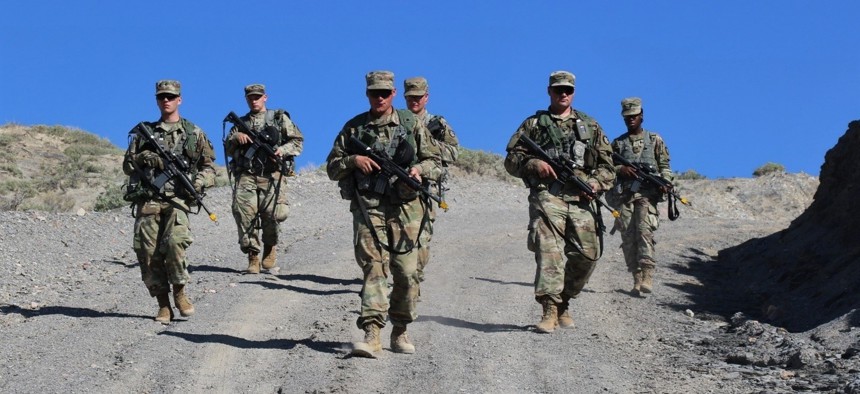
Soldiers from Headquarters and Headquarters Company, 1st Space Battalion, 1st Space Brigade, conduct patrolling operations as part of field training exercise Aug. 28, 2019 at Fort Carson, Colo. U.S. Army
Exclusive: US Army Wants To Train Hundreds of Soldiers in Coronavirus ‘Safety Bubbles’
Entire companies and battalions could be isolated in the field for a month, Secretary McCarthy said in an interview.
The U.S. Army is working on plans to continue training large groups of troops amid the escalating coronavirus pandemic by creating “safety bubbles” around groups of healthy soldiers, Secretary Ryan McCarthy said in a Thursday interview.
The idea is to test an entire company or battalion of soldiers, and if none have COVID-19, send them into the field for a month with prepackaged meals to do the kind of collective training exercises that social distancing guidelines have made risky on military bases throughout the United States.
“We’re going to look at how big the size of a cohort can be. This is all brand new for us,” McCarthy said. “These are concepts we’re looking at that we may have to put in play downstream in the very near future. Because, obviously, we can’t wait a year until there’s a vaccine.”
The Defense Department has sought to balance the need to protect troops from the virus while maintaining their readiness to fight. Some critics — including senior commanders within DoD’s own ranks — have argued that a healthy force is an essential part of readiness that is being neglected to prepare for a hypothetical war the U.S. isn’t fighting right now.
“We are not at war. Sailors do not need to die. If we do not act now, we are failing to properly take care of our most trusted asset — our Sailors,” Capt. Brett Crozier, commander of the aircraft carrier Theodore Roosevelt, wrote in an extraordinary March 30 letter to Navy leaders begging for help to evacuate and isolate the majority of his 4,800-person crew.
The key to the Army’s plan is pushing more coronavirus testing kits out into the field, McCarthy said. His service has a “substantial amount,” he said, but is still figuring out where to send them. (The first shipments went to deployed troops in Afghanistan and Iraq.) Right now, Army leaders don’t have a clear projection of how many troops they expect to be sickened by the virus. National health experts believe that 100,000 to 250,000 Americans are likely to die of COVID-19.
The Army uses the Center for Disease Control and Prevention’s hotspot models as a baseline and “we’re trying to apply it to our installations,” McCarthy said. But the CDC’s model is “not an apples-to-apples comparison, which is why we don’t have enough data to make a pure determination yet, but we’re getting close.”
Related: Coronavirus Is Rising Around US Military, Defense Infrastructure, Analysis Shows
Related: Pentagon Halts Domestic Travel by Troops to Slow Coronavirus Spread
Related: The Prognosis: Latest News on Coronavirus & National Security
The Army has already tested an early pilot model of the “safety bubble” concept. On Tuesday, some 800 soldiers were taken in 32 sterilized buses from Basic Combat training in South Carolina to bases in Virginia, Oklahoma, and Texas. The soldiers were screened for COVID-19 symptoms, but not tested for the coronavirus. The effort required more vehicles than normal because service members maintained social distancing on the buses, which were equipped with bathrooms so that they could travel without making any stops.
The biggest weakness McCarthy sees — the easiest opportunity for the virus to wreak havoc among Army troops — are combat arms units, like infantry battalions, and basic training environments in which recruits live and eat in close quarters.
“I see a lot of challenges there,” McCarthy said.
Over the past two weeks, he said, he spent considerable time with TRADOC commander Gen. Paul Funk looking at the protocols and thinking of ways to adjust.
As of Thursday morning, there were 893 cases of coronavirus among active duty service members, according to the Pentagon’s daily fact sheet.
Some service members have complained that the Pentagon — including Army leaders — didn’t do enough early on to prevent the spread of the disease amongst its servicemembers. In several cases, the Army moved before the Defense Secretary to put travel restrictions and other public health measures in place for its service members, giving the impression of an institution reactively lurching to respond to the ballooning crisis.
McCarthy said communication between senior leaders in the Pentagon has improved in recent weeks, streamlining the building’s response to the crisis.
“This is decentralized because this is a massive organization,” McCarthy said, referring to the Pentagon’s COVID-19 response efforts. “What we’ve done as a collective leadership team is meet more frequently, all the services and all the [combatant commands].”
“Some of it is good because by doing it uniformly with the services and OSD, it’s not, ‘Why are you Charlie?’ ‘Why are you Bravo?’” McCarthy said, referring to health protection statuses that the military designates its installations to dictate public health policy. “We don’t want to confuse anybody. That’s how this has kind of morphed.”
So far, senior leaders across the service branches insist that coronavirus has not reduced force readiness.
“Quite frankly, we’ve weathered the last month pretty well from a readiness standpoint,” McCarthy said.
Navy leaders insisted Wednesday that the Roosevelt remains “fully operational” now, even as over 4,000 of its crew members are being evacuated to shore-side facilities in Guam.
““If the ship needs to go, the ship can go,” Acting Navy Secretary Thomas Modly told reporters.
Defense Secretary Mark Esper has pushed back on the notion that the military should curtail its defense activities to combat the virus.
“There seems to be this narrative out there that we should just shut down the entire US military and address the problem that way. That’s not feasible,” Esper said during the White House’s daily coronavirus press briefing on Wednesday. “Our mission is to protect the United States of America and our people… I’m confident that the commanding officers and senior noncommissioned officers are taking every reasonable precaution to make sure that we practice as best we can social distancing, sanitizing environments, etc, consistent with that mission.”
It was not immediately clear who was suggesting that the military should “just shut down.”




